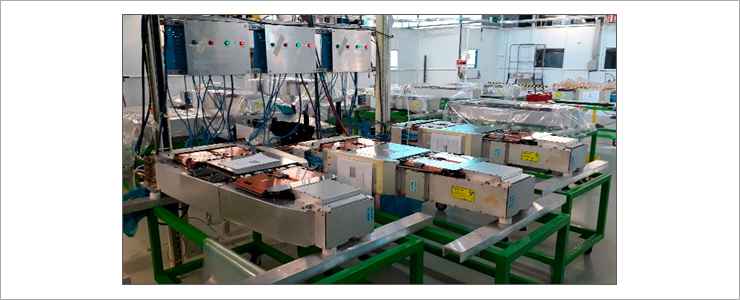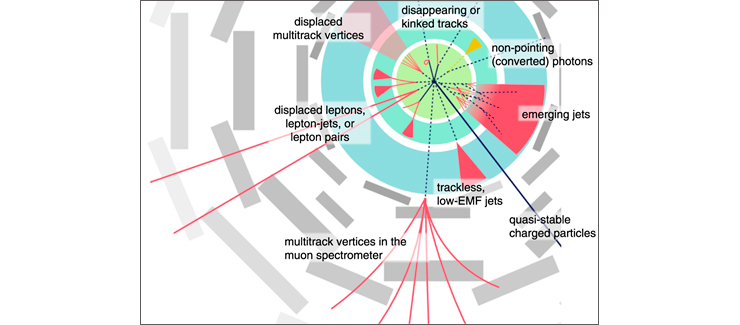Upgrade of CMS Detector at LHC
Publications, 03 June 2022
JINR scientists take an active part in the upgrade of the Compact Muon Solenoid (CMS), one of the four biggest experiments at the Large Hadron Collider (LHC) in CERN. JINR has been engaged in a wide range of works on the experiment and has been contributing a lot to the CMS since the stages of preliminary research and development. The first upgrade stage was concluded in early 2022. The second one will be continued in four years, when the LHC luminosity will be increased. Head of the CMS topic at JINR Vladimir Karzhavin and Head of the JINR Physical Programme at the CMS Sergey Shmatov comment on the upgrade stages.
The CMS experiment has a broad physics programme ranging from studying the Standard Model (including the Higgs boson) to searching for extra dimensions and particles that could make up dark matter. During two long-term shutdowns of the LHC in 2013–2015 and in 2019–2022, the first stage of upgrading the CMS detector was carried out. It ensured the efficient operation of all systems at high luminosity of the LHC over 1034 cm −2 ·s−1 with an increase in the energy of proton–proton collisions to the c.m.s. design value of 14 TeV.
“JINR specialists have made a great contribution to the upgrade of the detector systems of the hadron calorimeter and the muon system. Replacement, testing and commissioning of the readout electronics and service systems of the hadron calorimeter were carried out,” Vladimir Karzhavin, Head of the VBLHEP Scientific and Technical Department of CMS Physics, says. As part of the muon system upgrade, 108 detectors of four muon stations located in the high-occupancy area have been equipped with new high-speed electronics. Figure 1 shows the final stage of a long-term performance test of the ME1/1 detectors before their installation into the CMS detector.
 Fig. 1. Stand for long-term testing of the performance of ME1/1 detectors
Fig. 1. Stand for long-term testing of the performance of ME1/1 detectors
Currently, the preparation of the CMS muon system detectors for Run3 is being completed. This run will last until the end of 2025 (the expected integral luminosity will increase to Lint~350 fb−1).
Starting from 2029, the LHC is expected to operate at increased luminosity up to 7.5· 10 sup>34 cm−2 ·s−1 (High Luminosity, HL-LHC). It will increase the statistics by more than an order of magnitude (Lint~3000 fb −1). This will further allow studying thoroughly the nature of the Higgs boson and searching for possible deviations from the SM predictions, indicating the manifestations of signals of new physical phenomena. In particular, it is important to significantly improve the accuracy of measuring the coupling constants of the Higgs boson (expected accuracy is ~3–5%), since the observed contribution from the production of new particles may be much less than the current measurement accuracy (10–30%). The increase in data statistics will allow us to search for processes beyond the SM, which are characterized by cross sections that are below the threshold of the current sensitivity of experimental measurements (scenarios with dark matter particle candidates, extended supersymmetric models, Higgs-portal theories, etc.). Among them, we are particularly interested in processes in which the production of long-lived particles (LLP) is expected with decay vertices located at a considerable (from several centimeters to tens of meters) distance from the interaction point of proton beams (Fig. 2). Also, various scenarios for the search for new physics predict the production of particles with a transverse momentum much larger than their mass (boosted objects). Consequently, their decay products are very narrow jets overlapping in space.
 Fig. 2. Possible topologies of events at the production of long-lived particles (LLP)
Fig. 2. Possible topologies of events at the production of long-lived particles (LLP)
The registration of such processes requires a significant expansion of the possibilities of the event selection system, along with the use of nonstandard algorithms for event reconstruction, for example, reconstruction of tracks and measurement of particle energy using muon stations without using a tracker. Good separation of double jets, especially at high interaction density, requires a calorimeter with good longitudinal and transverse segmentation, which facilitates the measurement of particle flow energy.
“As the luminosity of the collider increases, the detectors and readout electronics must be adapted to operate at significantly increased radiation loads,” Sergey Smatov, the Head of VBLHEP Sector No.1 of New Physics at CMS, notes. JINR physicists are conducting a comprehensive study of the degradation of detector parameters when operating under HL-LHC conditions.
The second phase of upgrading the CMS detector to operate in the HL-LHC mode will begin in 2026 and will affect all the key elements of the detector: tracker, calorimeters, and muon system. JINR takes an active part in the upgrade of the CMS muon system and in the construction of the High Granularity Calorimeter (HGCal). A large amount of research and development work has been carried out, aimed at studying the radiation properties of materials and choosing technical solutions in the development of new detector systems.
The JINR group, together with specialists from the Belarusian State University (Minsk), actively participates in the construction of detecting elements (cassettes) of the HGCal. These cassettes consist of silicon sensors and scintillation modules installed on a copper cooling panel. In addition, our specialists have made the decisive contribution to the development, simulation and construction of a stand for testing the performance of HGCal cassettes. Tests, including those with cosmic rays, will be carried out under special conditions in the laboratory at a temperature of –35°C for two weeks.
It should be reminded that the first stage of the experimental data taking (Run1) took place in 2009–2012 at the energy of colliding proton beams √s = 7 and 8 TeV. During Run1, one of the fundamental results of the CMS experiment was the discovery of the Higgs boson. The CMS muon system plays a key role in registering the “golden” decay of a new boson (h→ZZ*→4µ). The forward muon station ME1/1, which has unique characteristics (spatial resolution of ~50 µm and time resolution of ~3 ns), provides precision measurements of the muon track coordinates. In Run2 at the LHC in 2015–2018, the LHC energy reached √s =13 TeV. The full volume of experimental data recorded by the CMS experiment over two runs corresponds to the integral luminosity of Lint~190 fb−1.
JINR physicists have been participating in the Compact Muon Solenoid (CMS) experiment as part of a collaboration of scientific centres of Russia and JINR Member States (RDMS) since the concept of the experiment was proposed in 1992.
JINR’s contribution was focused on the construction of detectors for the endcap of the CMS detector, including the design, construction and commissioning of the Endcap Hadron Calorimeter (HCal) and the forward muon station (ME1/1), and the participation in runs on data taking and physical analysis, as well as maintaining the effective operation of the detector.